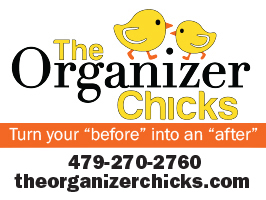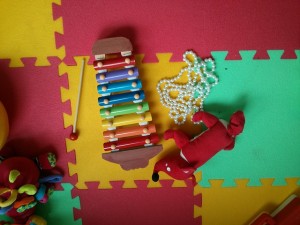Mamas, we met Amber Taggard years ago when her new business, The Organizer Chicks, was just a baby and she had become a mama to her first baby. Her business has taken off like a rocket since then, and when you read this Q&A, you’ll know why. Her life’s work is about so much more than putting “stuff” in order. She’s about helping people in ways that give them more peace, calm, joy and time for things that truly matter to them. We’re happy to share this sponsor interview because Amber is a “chick” you should definitely get to know.
Has organizing always come easily to you or is it a skill you developed over time?
I’d say that the desire for organization came naturally for me. I’m a typical oldest child in many ways — social, driven, and someone who likes and appreciates rules and processes. I learned early in life that I not only felt better, but thought more clearly and was more productive in an environment that was orderly.
My formal education — a Bachelor of Arts in Psychology and a Masters of Science in Clinical Mental Health — paired with my experiences helped me to develop the skills and the insight necessary to do what Professional Organizers do best, which is to help people make decisions and set up processes that they know they need to, but likely wouldn’t do on their own.
What made you want to begin your own professional organizing business? What was that first year of business like?
I was several years into a career in Higher Education, which I loved, before I started The Organizer Chicks. I traveled extensively and had a lot of job satisfaction, but finally, after a years-long attempt to start a family, my  husband and I were excitedly expecting our first child — a now-6-year-old named Ryan. Suddenly the thought of getting on one more plane or staying one more night in a hotel was more than I could bear, and I knew that it was time to make a change.
husband and I were excitedly expecting our first child — a now-6-year-old named Ryan. Suddenly the thought of getting on one more plane or staying one more night in a hotel was more than I could bear, and I knew that it was time to make a change.
I wanted to do something I genuinely loved and enjoyed, something that Northwest Arkansas would have a demand for, and something that would use my skills and education to benefit my fellow man. And ultimately, I wanted to have a real, meaningful career that could work around my new most-important-job-ever job: Mom. One of these days I’ll have to thank Ryan (and now his siblings Evan and Lana) for giving me the the drive to be brave and jump into the unknown! Six years and 16 employees later, I’m so grateful I made that scary, but important decision to quit my job and start my career.
My first year of business obviously coincided with my first year of Motherhood, and while there was a lot for me to learn about finding the right balance and running a business, I was thrilled to see business take off right from the start. One woman’s transformed craft room led to her friend’s organized home office, which led to her co-worker’s overhauled pantry, and so on. When you can help someone feel and function better inside the walls of their own home, that’s powerful, and word of mouth helped a momentum start to grow, and an official Facebook page soon followed.
One of my early struggles was that most people in middle-America have often never heard of, much less met or hired, a Professional Organizer. Mine is a field that many people only ever see on HGTV, or “Hoarders,” and I think there can sometimes be a stigma attached. People often reach out only after unsuccessfully trying on their own to get (and stay!) organized, and they call us feeling like they’re a failure, but here’s the truth — each of us have different strengths and weaknesses, and any one of my clients is going to be fantastic at 10 things that I just have no skill for.
That’s why we need each other — we lend our strengths to others who have weakness in a certain area, and vice versa, and we trade this thing called the dollar for that strength. There’s no shame in needing an electrician, a personal trainer, or a real estate agent — all of these people have specialized skills and training to help you get from Point A to Point B, and a good Professional Organizer is no different. The judgement stays out, and the help comes in.
Some people think organizing is just about putting “stuff” in order, but there are often a lot of emotions (anxiety, fear, guilt, nostalgia, etc.) attached to the things people keep. How do you help clients untangle the emotions that can keep them drowning in too much stuff?
One of the things I like most about my job is that no two days are alike, and that’s largely because no two clients are alike. We keep things for a wide variety of reasons, and often someone who can easily get rid of even the  nicest of handwritten thank you cards just can’t seem to part with those 12 black cardigans collecting dust in their closet. For most people, however, I find that keeping most often boils down to emotional attachments.
nicest of handwritten thank you cards just can’t seem to part with those 12 black cardigans collecting dust in their closet. For most people, however, I find that keeping most often boils down to emotional attachments.
The woman with the 12 black cardigans doesn’t look at that collection and see cotton-poly bends, she remembers the pride she felt when she wore cardigan #1 to her college graduation. She recalls the love and heartache she experienced when she wore #2 to her beloved grandmother’s funeral. And so-on. Particularly with women, clothing is especially tied to memories. Perhaps it’s the intimate nature of our clothing, as it hugs our curves and walks through our experiences with us, but this is a category that is repeatedly difficult for my clients to cull.
I lean heavily on my formal education in Counseling Psychology, and we practice a lot of what might be called “tough love.” We remind the client of the goals they said that they had for the particular space, and ask whether the keeping of this item or that gets them closer to, or keeps them further from, their goals.
We also work with our clients a lot on remembering that what we truly want to keep often isn’t the item itself, it’s the memory that the item evokes. Clients often need to feel that they have permission to let go of things, and we help them to relinquish what’s only serving as a memory-jogger by capturing that memory in another (preferably smaller and/or digital) format. For instance, we would suggest that a client set up a photo shoot with the beautiful handmade quilts that are sitting in boxes in their attic and make a coffee table book, complete with journal notes about who made each quilt, and where and when. Capture who the people were and what they meant to you. Then honor them — the quilt and the quilt maker — by giving the quilts as a donation to a local shelter so that they can keep someone warm tonight.
You’ll feel a thousand pounds lighter, and you’ll have blessed someone else while you were at it.
Tell us about one of your favorite before and after stories and what kind of impact it had on your client.
The saying “A picture is worth a thousand words” certainly applies to Professional Organization, but one of my stand-out favorite before and after stories can’t be seen in photos. It’s the story of a mom who had a very busy life with her husband, children, an in-law in the home, and a taxing corporate job. Because of the demands on her time, she felt that she couldn’t possibly accomplish all of her work during the typical work week, and had,  for years, been working Monday through Saturday.
for years, been working Monday through Saturday.
Over the course of several weeks we worked space by space, item by item through her home, identifying processes and habits along the way that were leading to not only inefficient use of space, but inefficient use of time. (I find that there is nearly always an overlap in physical organization and time management, and that was certainly the case in this situation.) When we were finished with our sessions, not only was their home more functional, easier to clean, and more peaceful, but I had been able to create for her a Master Schedule that allowed her to see that she could, with better planning and organization, reclaim her Saturdays for herself and her family.
It’s experiences like these that remind me of what an honor it is to do what I do for a living, and how much I appreciate my clients, who let us into their personal spaces — their homes, their tax records, their calendars – in order to get the help they need.
Which room of the house is your favorite one to organize and why?
Some of my employees love kitchens the most, some love home offices, but I’d have to say master closets are my personal favorites, and specifically, the women’s side of the closet. As you can imagine, I’ve seen hundreds  and hundreds of women’s closets at this point, and unfortunately, I often find that the rod space is jam-packed full of clothing that just flat out doesn’t fit anymore, and often because it’s too small.
and hundreds of women’s closets at this point, and unfortunately, I often find that the rod space is jam-packed full of clothing that just flat out doesn’t fit anymore, and often because it’s too small.
So walk with me through the morning’s events… You wake up, stretch, and decide to get dressed and tackle the day. You walk into your closet and find that not only are the items that do fit you hidden and hard to get to, but they’re being overwhelmed with all the clothing that used to fit you. When you were younger. When you were smaller. When you were better. Someone is calling you fat first thing every morning, and that person is you.
I love working in women’s closets because it’s an opportunity for me to go through these items one-by-one with ladies and really assess whether that precious rod space is being used for the pieces that work for us, or if it’s a heckling ground for the sizes of years gone by to remind us that we’re not where we think we should be. Rod space is for what fits our bodies here and now — what we look good in, feel good in, and would purchase all over again if we were in the store today. Taking those taunting size 4’s off the rod and putting them in a bin that can sit quietly at the top of your closet doesn’t mean you’re abandoning your goals or will never be that size again, but it does mean that between now and the time you achieve that goal, you can start your morning with positive feelings and with the efficiency of a rod of clothing that you know you can select from.
If you could give moms only one piece of advice that would make the biggest difference in their ability to stay more organized, what would it be?
Ultimately, the simplest route between chaotic and calm is to have less, and while this is true for every room and every age range, I would particularly encourage Moms to give their kids the gift of less.
 Think of a time when you’ve had what felt like an insurmountable work load staring at you. Those overwhelming feelings are not unique to adults – children can and do feel them, too, they’re just not equipped to recognize and articulate them. I encourage a 1:1 ratio of minutes to years when it comes to toys.
Think of a time when you’ve had what felt like an insurmountable work load staring at you. Those overwhelming feelings are not unique to adults – children can and do feel them, too, they’re just not equipped to recognize and articulate them. I encourage a 1:1 ratio of minutes to years when it comes to toys.
For example, a 4-year old needs to have access to no more toys than it takes her 4 minutes to clean up by herself (after a few days of “training” with Mom or Dad, of course), and there are several good reasons for this: We want to set up our children for success; We want to help our children develop intrinsic motivation to be tidy; and we want to allow children the blessing of boredom.
Boredom is too often treated as a terrible enemy to be avoided at all cost, but keeping the number of available toys lower keeps kids from “toy hopping” — jumping from one exciting new figurine or gadget to the next without any deep, extended, imaginative play. Boredom is the breeding ground of new and creative ideas, and it also is an important departure from a society that says we must be stimulated at all times. Constant media, increased consumerism, and the increase in diagnoses of ADHD all correlate, and it’s no surprise.
It’s worth noting that you don’t necessarily have to get rid of the toys that push you above and beyond the 1:1 ratio. Feel free to keep a bin or two of excess toys out of the reach (and sight!) of your kiddo, and swap the toys out from time to time. This will keep the toys fresh and exciting while still keeping the task of clean up doable.
Note from the Mamas: We’re going to keep picking Amber’s brain for organizing advice over the next few months, so be sure to watch for those upcoming posts. And next week, we’ll host an AWESOME giveaway from The Organizer Chicks that you do NOT want to miss. Look for it on Monday, January 16th. Until then, get more info about what Amber’s company offers by clicking here.
